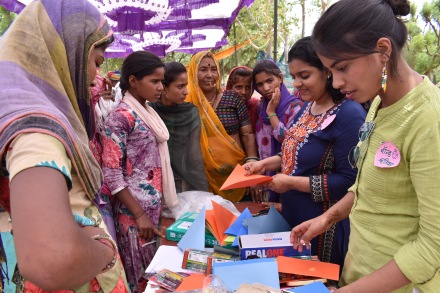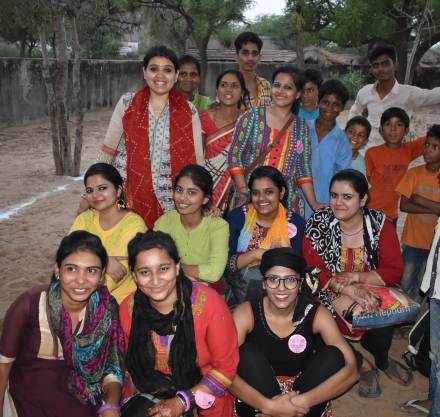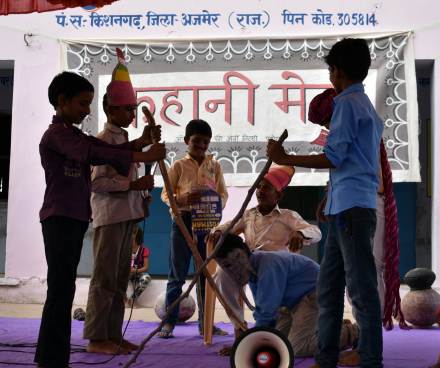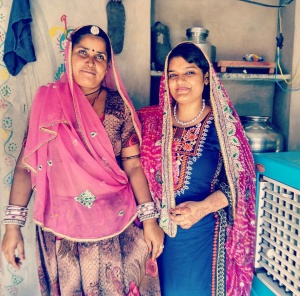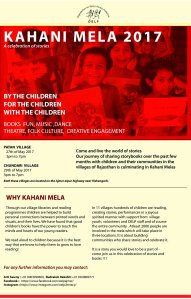Stories have the power to bond diverse groups of children, youth and adults in a true spirit of sharing and engaging. Stories build bridges between the old and young; between the oral and written worlds and between different worlds of experience. Stories talk about people, places dreams, possibilities. Through our village libraries and reading programmes children are helped to build personal connections between printed words and visuals, and their lives.

The OELP village library programme, with village bahus (daughters-in-law) at the helm as librarians, has been conceptualized with the tall aim of building communities of engaged readers within low literate, rural societies.
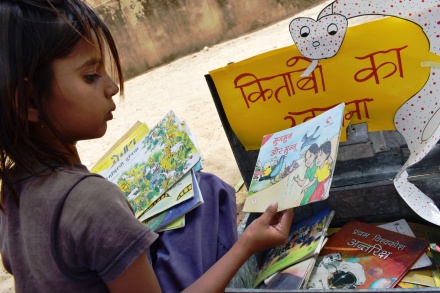
Why the Kahani Melas ?
- The Kahani Melas are not stand alone events but are woven into ongoing process oriented engagements with books and stories
- They engage children and their communities through sharing and celebrating stories and books.
- Unheard and unseen stories, whether documented or not are an important part of these celebrations.
- Stories have also catalyzed a coming together of teams from different languages and cultures; from as far as Delhi and Gujarat and connecting them with the children and communities in rural Rajasthan through the universal language of stories, while remaining unmindful of the scorching heat and parched landscape.
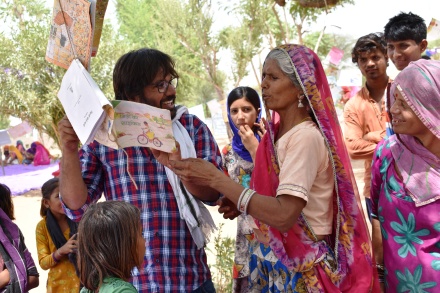
About 5000 children, youth and adults have been involved in various ways. In eleven villages located in the Kishangarh Block of Ajmer District hundreds of children have been reading, presenting and creating stories in a variety of ways. They have also connected with older people to discover local stories and other knowledge forms along with various aspects of their socio-cultural heritage. They have shared their discoveries through charts, village maps, story mobiles, story boards, puppets, books created by them, along with visual art forms and performances based on stories and storybooks.
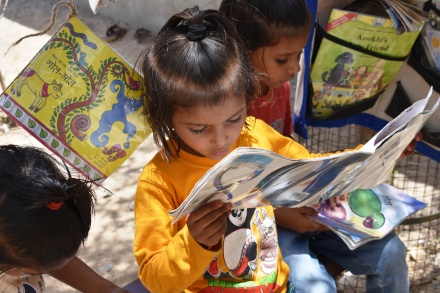
Our aim is to create a platform for rural communities to develop deeper connection with stories and books, and to encourage them to actively engage with their children’s processes of self actualization and learning.
While reflecting on the Kahani Melas, Prabhash Chandra, a participating theatre professional from Delhi quotes:
“A childhood without books – that would be no childhood. That would be like being shut out from the enchanted places where you can go and find the rarest of joys” – Astrid Lindgren
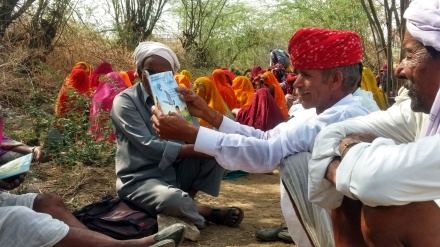
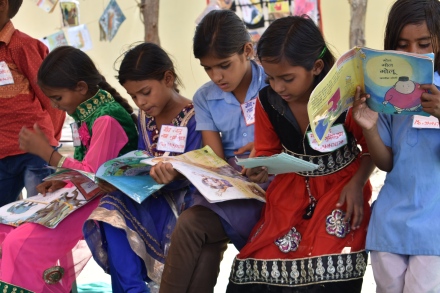
Our challenge has been to build communities of readers and writers within low literate societies that are entrenched in oral traditions. Through this slow and gradual journey, stories have emerged as a vital element in this process.
Ownership of the community
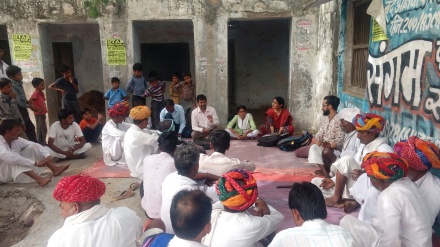
The entire cost and organization of the three Kahani Melas events and some of the costs of the preparatory processes that led up to them over two weeks were borne by the village communities and local Pachayats, The Sarpanches from Kalyanipura and Patan Gram Panchayats took on leadership roles in catalyzing village communities and offering wholehearted support, i.e. fund raising and organizing food for 300-400 children at each Mela.
Villagers welcome the volunteers
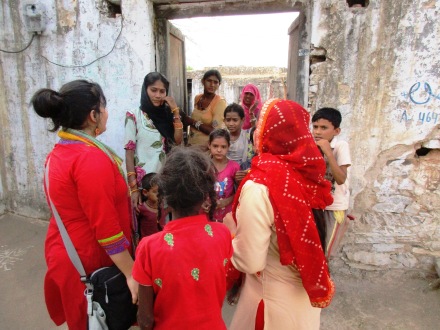
Villagers opened up their homes and hearts to the volunteers. Different village homes organized lunch for the volunteers each day. The response from the village communities has been overwhelming. We view this as the start of new journey and a process that we will try to continue in organic ways.
This ongoing effort, spanning few months before the melas, received support from the American India Foundation. OELP’s intensive efforts found depth and enthused energy under the leadership of Jaya Iyer. It led to the coming together of an enthusiastic and committed group of volunteers and resource persons from Delhi. Bal Mitras from AKRSPI Gujarat also engaged with commitment in the final preparations.
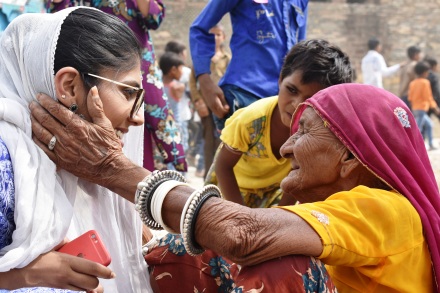
The underlying themes
- Building bridges (to connect oral with written; local with global and rural with urban)
- Self actualization – through pride in one’s socio-cultural heritage
- Fun and creativity – to give wings to flights of imagination, creative expression, reflection and thinking
Guiding principles were drawn up and it was decided to follow them in all processes and plans. They gave a firm basis on which to design, choose materials, participants etc. and pertained to the following heads:
- Environment : Earth conserving, not depleting
- Inclusive : In spirit and design
- Diversity and inclusiveness
- Process oriented
- Child at the centre – community in focus
- No allegiance to any party/ religion/ group
- All about stories and books
The overall design was conceived as a coming together of the young and old, rural and urban through an active engagement with stories
The team’s structure: A steering committee was formed and met a few times to put together a conceptual outline of the event. With the involvement of steering committee five task teams were formed for the event management:
- Design team
- Communications team
- Logistics team
- Event facilitation team
- Finance team
Each team was headed by one or two people with further subgroups within each of these heads. Tasks were listed and detailed out for each team, and specific roles and responsibilities spelt out.
The pre-event planning and preparation
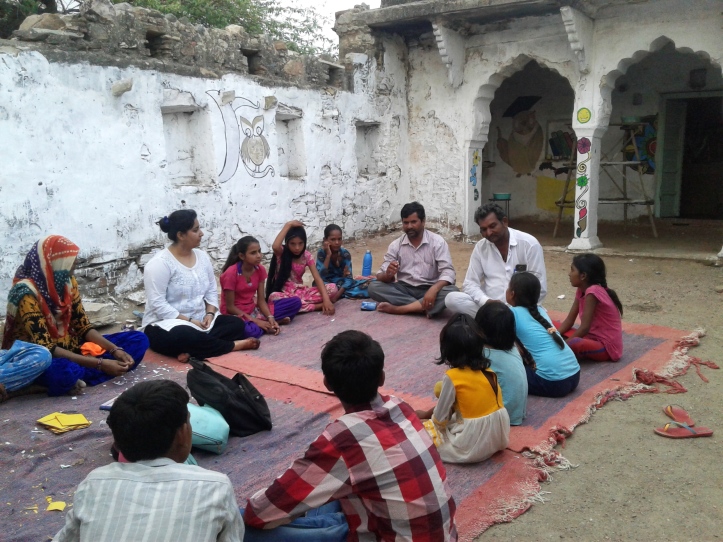
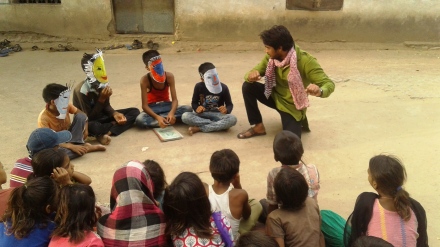
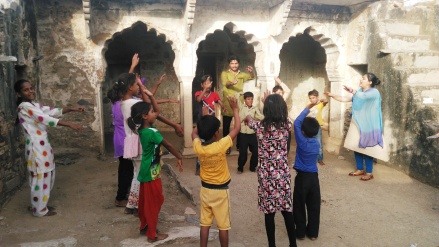
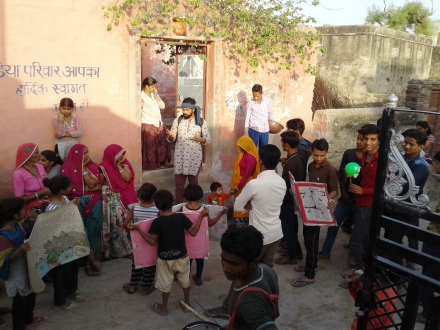
The preparation included:
- Skill building workshops for the OELP team
- A series of skill building workshops for the children
- Selection of volunteers by Jaya and her team in Delhi
- Orientation of the volunteers and Gujarat team
- Planning meetings
- Review and reflection meetings
The processes at the village level
Volunteers from Delhi, Bal Mitras from AKRSPI Gujarat and OELP team members supported the pre event processes at the village level in small groups. They received a warm welcome from the communities.
Community mobilization through village rallies
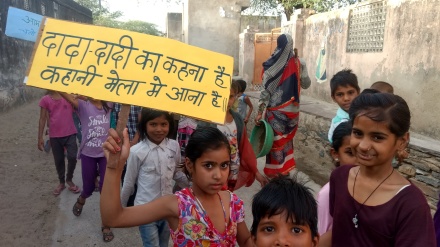
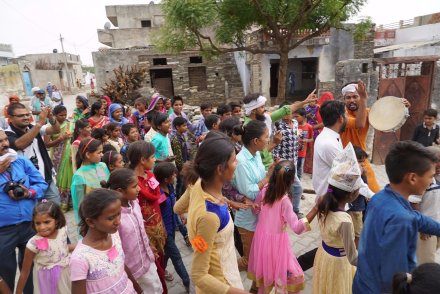
Community planning meetings
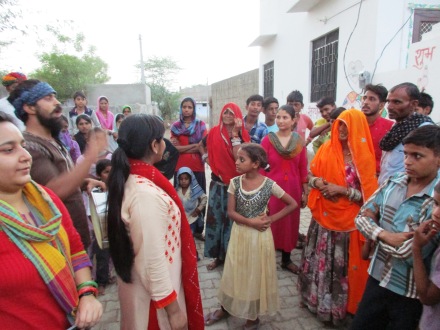
Planning meetings at the MNREGA work sites
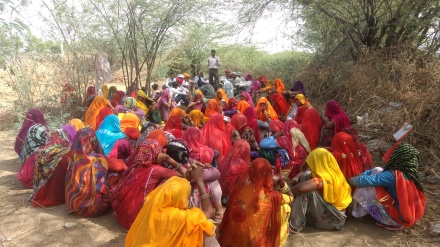
Engaging with and supporting the children’s creative efforts
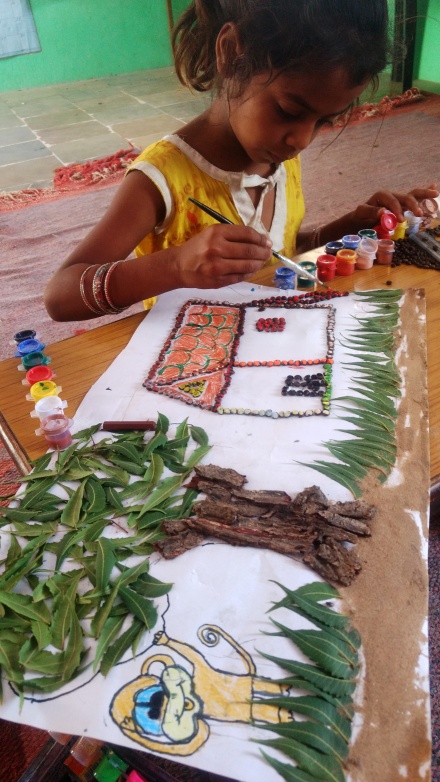
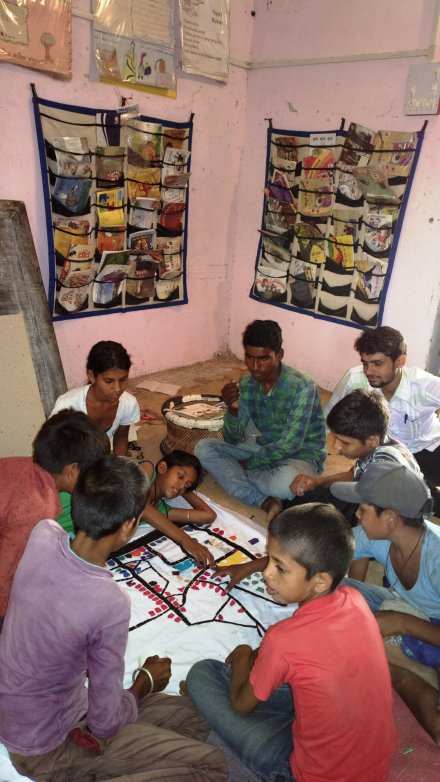
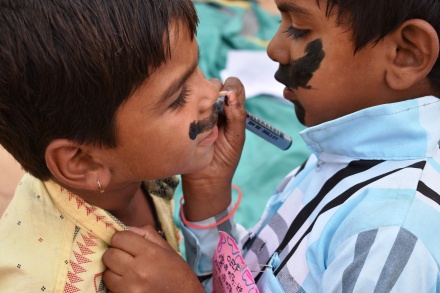
What made these Kahani Melas special?
- Each Mela is a culmination and part of larger, longer process of engagement with children on relevant themes and not a stand-alone event.
- Each mela is for children, a fun event yet with depth and meaning and themes which are woven into every strand. These themes inform all the activities, design and spirit of the mela and not separated as – content section, which are serious and fun activities, which are frivolous.
- Each mela is also by children – an attempt to involve children as partners/ co- creators to the event and not as mere passive recipient or spectators.
- It is community-led and centered. Each mela was supported by resources generated from within the village communities
These melas are learning-oriented – for everybody involved – young and old, rural and urban; it is a space for learning and enhancing selves for the volunteers – many of whom were from Delhi; for colleagues from Gujarat; for teachers and members of the local communities; for Education Department officials; for visitors from other organisations and for the OELP team.
Glimpses from the Kahani Mela events
The events which took place on 25, 27 and 29 May 2017, involved over 1000 children and reached out to 4000 adults. Around 500 participated intensively in the sessions and workshops and other activities. A team of over 15 volunteers and resource persons were involved along with 10 AKRSPI team members from Gujarat and 25 OELP team members
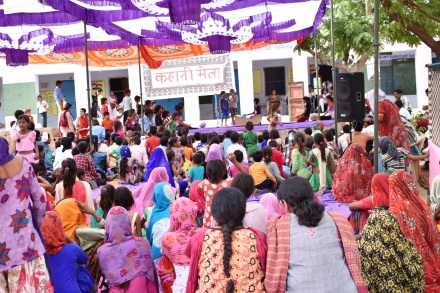
Performances – enactments, role plays, puppets based on stories or poems
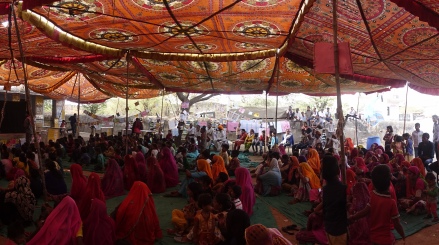
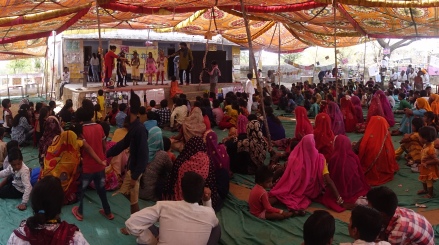
Open activities – book based games, treasure hunts, visual art
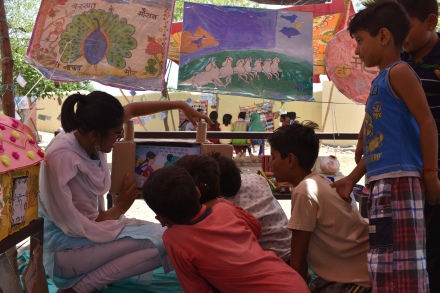
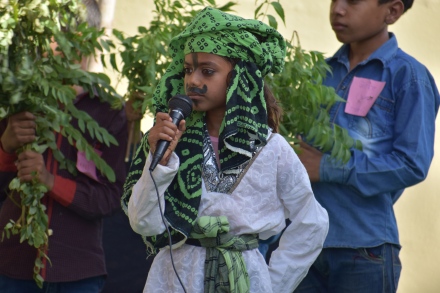
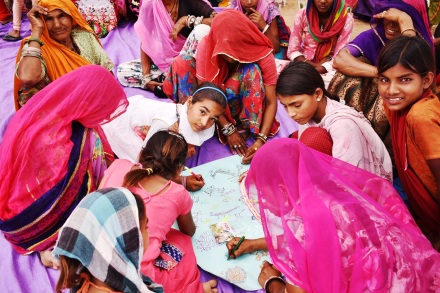
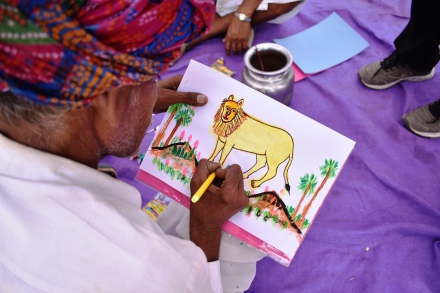
Exhibition
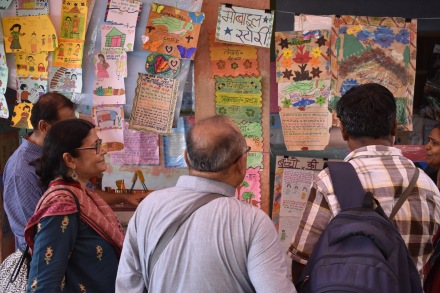
The response
From the panchayats
- Mobilized community
- Participated actively in community meeting
- Support major costs for the final event
From the community
- Participation
- Mobilization of resources – financial and in kind
- Looking after volunteers and giving them lunch in village homes
From the State
- Access to schools for practice and as event venues
- Participation of govt teachers in planning meetings
- Education Department officials attended the events , despite work pressures
Other NGOs
Representatives from AKRSPI, Gujarat; Pratham, Ekalvya, Barefoot College, Edu_ Adda, Delhi, participated in the events
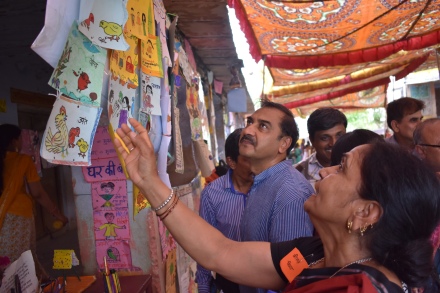
The Block Education Officer joins the Mela in Kalyanipura
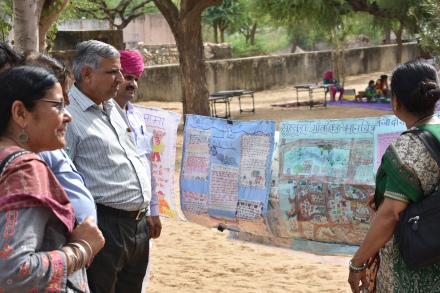
Reflection and feedback
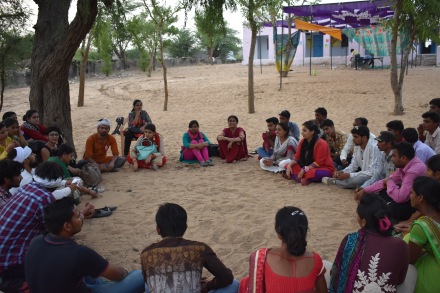
Feedback and follow up workshops continued after the event to ensure continuity and connection. The overall feedback from students, teachers, resource persons and OELP staff was very positive and showed the way for future direction and activities.
Challenges and struggles in the field
The role played by the village bahus has been pivotal in doing the foundation building ground work leading up to the Kahani Melas. Some glimpses of their small triumphs and their struggles and challenges are being shared below:
Nallu in this village the OELP team had made a conscious effort to include children from almost all the mohallas , like the Lohars; Mali; Kumar; Jat and Regar mohalla. About 20 to 25 children were participating regularly from the Regar mohalla. However about 6 days before the mela there was a wedding in a Regar family and the bridegroom was killed in an accident in Kishengarh, so none of the children from the Regar mohallah participated. These are challenges that working in th field has to constantly deal with.
In the same village, two days before the Kahani Mela the school was handed over to a family from the Mali community for a wedding and the OELP teacher was asked to clear out her classroom. She panicked as they has work to complete. She decided to take all her children home. However there was not enough space. She then phoned the school principal and shared the situation with him. He did not hesitate for a moment. He came to Nalu and opened up a room in the secondary school for the children to continue their preparations.
One day before the mela a close family member of the teacher was killed in an accident. She had to leave immediately for her paternal village; however she knew that parents would send their children to the Kahani Mela only if she accompanied them. So she decided to stay back and accompany the children to the Kahani Mela the next day, even though she had to face the wrath of her kith and kin.
Relavata – A huge and successful effort was made by the OELP teacher to include children from the Kalbelia community, which is a marginalized community. However, the Bagriya community, which remains as another ostracized social group refused to let their children participate. This is a challenge that we will continue to work on in the near future.
Paner- is an interior village. A huge effort was made in this village to include all communities, and the OELP team was successful in including quite a few children from the Kalbelia community. What was disappointing however was that despite concerted effort girls were not sent to participate in the Kahani Mela, and in the end it was only a group of boys who participated.
Isha Attri – a volunteer from Delhi writes:
“ Before going to Chundari for volunteering, it was told to us that a child had died in some accident at a farm. The entire village mourned and no one cooked for two days. This experience was different for me as it taught me that the village does not have several different homes rather the village is a big family in its own way. They not only share happiness but sadness too. Going to Chundari made me feel a part of a huge family, who never made me feel homesick.
While working with the children there was optimism, positively at a totally different level far beyond any Delhi school. The positive energy that came from the school staff and students always reenergized me, even though I was tired or sick. Looking at the faces of the kids, their wish of learning new things, their welcoming attitude never made me feel that we can’t do.”
From Manju and Kamla, team members of OELP in Ralavata Village:
“A few older girls wanted to perform the Ghumar dance. This request was placed before the organizers, since the focus of the Mela was on stories and not dances. The issue was discussed and it was decided that since this dance was also in the a form of story narration, therefore, if the group connected with the story behind the Ghumar dance and presented the story along with the dance it will be fine to perform it. This was communicated to the team in Relavata. The group of girls along with the volunteers and teachers decided to talk to different people within the village to find the story of Ghumar. Some villagers suggested that they go to the Rajputs as Ghumar was a dance performed in the Rajput “gardhs” (forts) They went to Sumer Singh ji; and then to the “kila” to meet Hanumant Singh ji. Some members of the group belonged to the lower castes, and their entrance into the “kila“ was banned. To get past they were presented to the Rajputs by the team as outsiders.”
This later became an issue which was debated within the team- whether the dance was more important than the self respect of individuals from a lower caste group and whether what they had done was the correct things to do?
The Rajputs, including the women were however not able to give the story, pointing to the rapidly disappearing oral cultural heritage, and the need to sensitise children towards it. It was the wife of Ramu ji Bhand’s who finally shared the story of Ghumar. Ramu ji is no longer alive. The Bhands are the local minstrels.
Anjali Tripathi– a volunteer from Delhi writes:
“There are many stories that are not written and not heard but locally pass on from one generation to the other. They are also stories. . . . to make children accept the fact that we can also write such a story and it can be read by many people. Formal storybooks are only a part of it. I seriously put forward a discussion with the children – that how can these stories be published and what is the meaning of these stories and what is their relevance? What is the source of these stories – and how can we differentiate between historical narratives and imaginative stories? . . . That it is important to know about the roles of sources and authenticity, so that all the childen actually realize that there are many more stories in our pasts; and we don’t have only one past; i.e. we have many pasts. To make them understand this point, I asked them to write down stories shared by the members of the village regarding the history and settlement of Relavata. It’s just that they need to mention the source i.e. the name of the person from whom they are getting the information”
Evaluation and follow up
Through an informal process of feedback and internal review we have arrived at the following broad post melas conclusions:
Some achievements
- We were able to successfully mobiles the village communities and give them a sense of ownership of the melas
- We were able to engage members of the village communities with books and displayed texts in a variety of meaningful ways
- We were able to provide a place for local stories and other knowledge forms
- We were able to bring together urban and rural youth through relationships based on cooperation, mutual respect and understanding
- We were able to successfully decentralize roles to a large extent while preparing and organizing the events
- We were able to keep the central focus on stories through most of the activities that were planned
- We were able to engage with a variety of stakeholders
Some issues / aspects that need to be addressed and reflected upon
- We have still to reach the unreached children from a number of marginalized communities if we are to be truly inclusive
- A few children, especially boys tend to dominate – we need to address with greater depth
- We tend to become product oriented. We need to address and understand the product vs process perspectives so that we make some informed choices in future, while addressing the needs of different stakeholders
- We can improve some aspects of the event management
- OELP needs to orient volunteers to its work and context. We were unable to do this, and realize its importance
- We need to improve our communication skills especially on the social media so that more voices from the field get heard.
“Few children learn to love books by themselves. Someone has to lure them into the wonderful world of the written word
– Jim Trelease
